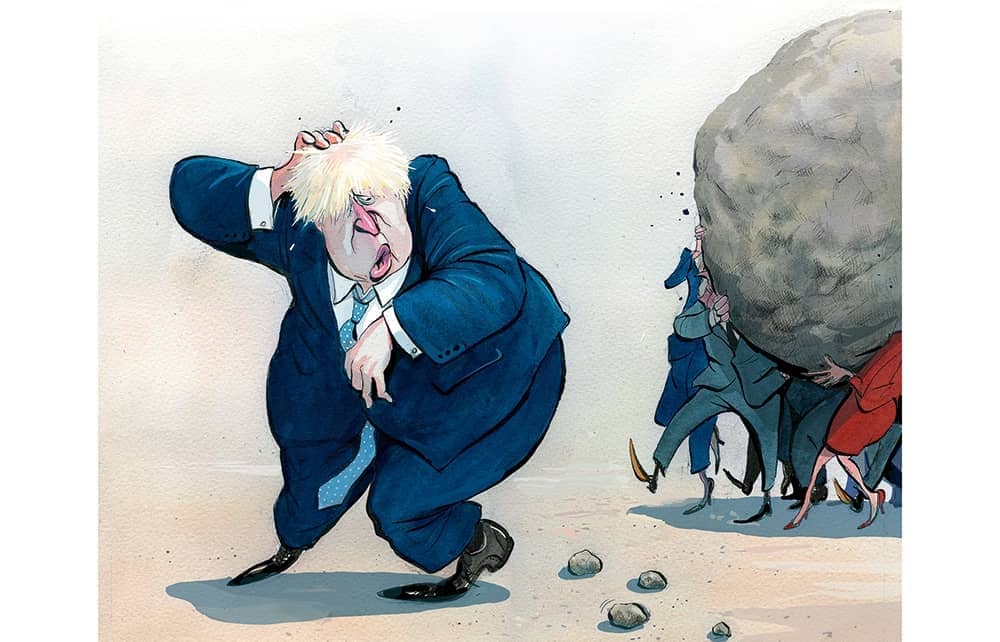The Tory party knows it has a problem with plotting. Of its last nine leaders, six have faced a leadership challenge of some sort. The current rules for removing a leader are designed to constrain the party’s appetite for regicide – no one can be challenged unless 15 per cent of the MPs write demanding a no-confidence vote, and the incumbent benefits from a second layer of protection: win, and they can’t be challenged again for a year.
The purpose of this year of grace is to ensure that rebels can’t keep coming back until they have finished off a wounded leader. But this being the Tory party, the rules are not set in stone. They are determined by the group of MPs who run the 1922 Committee of backbenchers. They can change them at a time of their choosing. Given how close Monday night’s vote was, rebels are already thinking about how they might engineer another in the next few months.
They fell 32 votes short this week. So how to find 32 converts? The coming by-elections in Wakefield and Tiverton might be sufficiently traumatic. If Boris Johnson loses a Red-Wall seat to Labour and a normally solid Tory seat to the Liberal Democrats on the same day, it will cause concern at both ends of the Tory parliamentary party. His great claim is to be an election winner, but that result would suggest he can no longer perform this service. One cabinet loyalist was terrified about the no-confidence ballot happening after these by-elections, believing that if both seats fell, Johnson would have been done for.
As a former cabinet minister who voted against Johnson puts it, ‘If we had been more organised, we would have withdrawn 30 letters on Monday morning, and put them back in after the by-elections.’ Wakefield is said to be roughly in line with what one would expect from the national polling. This means the Tories will lose the seat, and by a decent margin. But the bigger worry is about Tiverton and Honiton. The Tories have a 24,000 majority there, but the expectation is that the Lib Dems will take the constituency handsomely. One Tory MP has been telling colleagues about knocking on 100 doors there and finding only ten Tory voters. Tiverton’s loss would cause a prairie-fire panic among Tories in safe rural seats. They will fret about what the defeat means for them and their prospects and wonder if keeping Johnson will mean losing their job.

It is worth remembering that when the Tories lost Chesham and Amersham, where the majority was considerably smaller – 16,000 – Tory MPs demanded, and achieved, the abandonment of planning reform: the government’s one major supply-side policy. What will they want if Tiverton falls?

This month, though, is too soon for a change in the rules. So Johnson has a little time on his side.
Those close to him say that he understands the ‘craving for more of a sense of direction’ and the need to set out a more distinctly Conservative agenda. They point to his emphasis on ensuring value for money in public spending at cabinet on Tuesday, and the investment that he hopes will come from reforms to Solvency 2, insurance regulations inherited from EU membership. Loyalists argue that the new team is still clearing up old messes, and it will take time for the fruits of their labours to become apparent. Johnson has, once again, taken to promising tax cuts.
To use his time wisely, he will need a slick operation. The last few days – and the chaotic whipping – suggests Downing Street is still not working as it should. One ally says that rather than give the new team time, ‘he’s got to change the team again’. But a fourth reboot will raise the question: why did the last three not work?
The power of the 1922 Committee stems from the fact that it represents the back benches of the party
It is true that the campaign to shore up Johnson was oddly lacklustre. Downing Street mis-calculated on the numbers – at the end of last week they were convinced the rebels were still some way off the 54 letters that were required – and they failed to use parliament’s half-term break to reach out to MPs. Worryingly, some figures in No. 10 only found out about the no-confidence vote from the TV. It is ‘not a united team’, says one insider.
Another problem is that Downing Street fails to stick to its message. In the last few weeks it has backed £21 billion of spending to help families with their energy bills, but it has barely spoken about it – instead banging on about bringing back imperial measures. This week, it announced major NHS reform on Tuesday before turning to housing. Moving from topic to topic in this way reveals a government that is frenetic and unfocused. As one aide concedes, ‘The spraying around of different policies doesn’t work.’
Worse for Johnson, he has critics on the right and left – so policies that please one set of MPs annoy others. The rebels want different things, and for many of them the issue is the PM himself. This also means that a reshuffle may not be of much use. Lots of new faces round the cabinet table and members of the 2019 intake being given ministerial jobs would risk creating enemies among those who were culled from government.
Even a small reshuffle would cause problems. Some ambitious MPs who did not land jobs would conclude that Johnson was too weak to promote them, and there would be disappointment among those who expected to be rewarded for their support. I understand a reshuffle is not expected in the next few days and July is the most likely time for one.
The biggest danger to the Prime Minister remains the privileges committee’s investigation into whether he misled parliament. This is not yet under way, but once it starts it will return partygate to the headlines. This in and of itself will be a problem for No. 10, given that Tory MPs are totally fed up with the story and just want it to go away. The inquiry is expected to be chaired by a Labour MP and will have the power to appoint legal advisers.
At the mild end, Johnson may well be chastised for not having corrected the record earlier about his claim that the rules were followed at all times. If the committee does criticise him for this, or goes further, then that will bolster the argument that Tory MPs should be given another confidence vote.
The decision on whether or not to hold a second leadership contest this year would be for the executive of the 1922 Committee, the so-called ‘men in grey suits’. There are 17 members (there are meant to be 18, but one of their number has joined the government payroll), of whom five have gone public with their desire for Johnson to go, while six have announced they back him. No one can be sure how the other six split – but given that Johnson lost the back benches by a relatively large margin (the vast majority of the 160-odd payroll vote will have backed Johnson), it would be a surprise if most of them had supported the Prime Minister.
To complicate matters further, there may be a new round of men in grey suits before Johnson’s fate is decided. Members of the 1922 Executive are elected, and given that it can decide the leadership rules, these elections are likely to be more vigorously contested than usual.
The power of the committee stems from the fact that it represents the back benches of the party, and only the backbenchers are allowed to vote on who runs it. This may well lead to an executive more inclined to a rule change. If they want a second vote, then they are likely to get one. As one leading rebel puts it, ‘It depends on the ’22 changing the rules. But the ’22 are the representatives of the back benches – more than half of whom voted against the PM.’

The executive in fact did consider changing the rules to allow a second vote within a year when Theresa May was leader. May saw the writing on the wall, realised there was a grassroots attempt to remove her, and resigned. The executive has not yet discussed changing the rules this time, but two views are forming. One view, the case against rule change, is that the current situation is very different from that which the party faced under May: the government has a majority in the House of Commons, it can still get its business through, and the fixed-term parliament act has gone, so there’s none of the parliamentary deadlock which that created. To change the rules now, they say, would destroy the purpose of the year-long grace period – which is to allow a leader to stabilise themselves after a confidence vote.
The contrary case is that no prime minister in living memory has been referred to the privileges committee and that Tory MPs should be given a chance to react to any fresh information that emerges. A less high-minded way of putting it is that needs must, and it may become increasingly clear in the next few months that the public have made up their minds about Johnson. Tory MPs might need to jettison him to save their own seats. Added to this, Johnson is not the resigning type, so MPs may have to take things into their own hands if necessary.
A crucial figure in all this will be Sir Graham Brady, the chairman of the 1922 Committee. He was first elected to this role in 2010 and has held it under three Tory leaders now. He has fended off several efforts to unseat him, because Tory MPs have trusted him to represent their interests.
Sir Graham is not a gung-ho figure. You don’t survive in an elected position in the Tory party for 12 years, under three prime ministers, if you are. But he has an acute awareness of what backbenchers want. If it became evident that a clear majority of the parliamentary party wanted another vote, it would be a surprise if he did not steer the ’22 to oblige.
Any Tory leader who has had more than 40 per cent of his parliamentary party vote against him is vulnerable – whatever the rules may say. The worry for Johnson is that his internal critics are continuing to increase in number and are determined to come back for another go. On Monday they wounded him. The next time, they intend to finish him. And, as they see things, it really is only a matter of time.







Comments